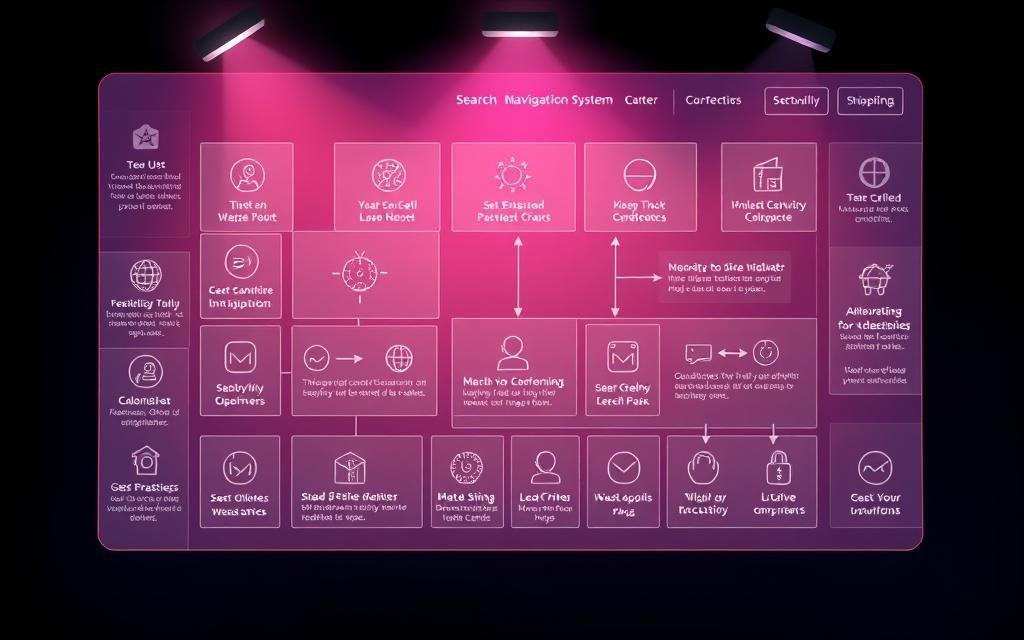In today’s online world, having a virtual storefront that tops Google is key for sales and growth.
To boost your online shop, focus on optimizing your product feeds. Also, use manufacturer prices to get better Google Shopping rankings. Google says these steps can really help your online presence.
By using these methods, you can get more people to visit your e-commerce store. You’ll also attract more customers who are really interested in what you offer.
Key Takeaways
- Optimize product feeds to improve Google Shopping rankings
- Leverage manufacturer prices to boost online visibility
- Enhance your virtual storefront to drive sales and growth
- Implement effective SEO strategies for online retail success
- Increase traffic to your e-commerce platform
Understanding E-Commerce SEO Fundamentals
The digital marketplace keeps changing, and knowing about e-commerce SEO is key for online stores to lead. E-commerce SEO is different from traditional SEO because of its unique challenges and needs.

What Makes E-Commerce SEO Different
E-commerce SEO focuses on making product pages, categories, and other e-commerce elements better for search engines. Unlike regular websites, e-commerce sites have lots of products, many variations, and more pages. This makes SEO harder.
Key differences include:
- Large product catalogs need better crawling and indexing
- Inventory and prices change often
- User reviews and ratings affect rankings
- There’s a lot of competition for product keywords
Key Ranking Factors for Online Stores
Google looks at many things when ranking e-commerce sites. Some top factors are:
- Product availability and pricing: Products must be in stock and priced right
- User reviews and ratings: Good reviews help credibility and rankings
- Page loading speed: Faster pages are better for users and rankings
- Mobile responsiveness: Most shoppers use mobile, so a good design is key
Google also values user experience. Things like bounce rate and dwell time matter for e-commerce site rankings.
The Role of User Intent in E-Commerce Search
Knowing what users want is key in e-commerce SEO. People looking for products online usually want to buy or learn something. E-commerce sites need to match their content to these needs.
“The key to successful e-commerce SEO is understanding your customer’s search intent and providing relevant, high-quality content that meets their needs.”
By matching product pages and categories with what users want, e-commerce sites can rank better. This brings more relevant visitors and boosts sales.
Optimizing Your E-Commerce Store Structure
Improving your online store’s structure is key to better search engine visibility. A well-organized e-commerce store makes browsing easier for users. It also helps search engines crawl and index your site more efficiently.
Google suggests grouping products into categories and subcategories. This structure helps search engines understand your digital commerce platform better.

Using descriptive URLs is crucial for optimizing your store’s structure. Instead of generic URLs, use ones that include target keywords and describe the page’s content. For example, “example.com/men/shoes/nike-air-max” is better than “example.com/product123”.
It’s also important to avoid duplicate content. Duplicate content can confuse search engines and lower your page rankings. Make sure product descriptions are unique. Use canonical URLs to manage duplicate content issues.
A well-organized online store benefits from clear categorization. This helps users navigate and search engines rank your content better.
| Best Practices | Description | Benefits |
|---|---|---|
| Organize products into categories and subcategories | Create a hierarchical structure for products | Improves user experience and search engine crawling |
| Use descriptive URLs | Incorporate target keywords into URLs | Enhances SEO-friendliness and clarity |
| Reduce duplicate content | Ensure unique product descriptions and use canonical URLs | Prevents confusion for search engines and maintains ranking potential |
By following these strategies, you can greatly enhance your e-store’s structure. This leads to better search engine rankings and a more enjoyable user experience.
Technical SEO Elements for Digital Marketplaces
For digital marketplaces, technical SEO elements are key to boosting visibility and sales. A well-optimized e-commerce store can climb search engine rankings. This leads to more traffic and revenue.
Site Speed Optimization
Site speed is a big deal for search engines. A slow site can cause people to leave quickly and buy less. To speed up, e-commerce sites can use browser caching, compress images, and minify CSS and JavaScript files.
Google PageSpeed Insights can spot areas for improvement. It’s also important to make sure the site works well on all devices and screen sizes.
| Optimization Technique | Description | Impact on Site Speed |
|---|---|---|
| Browser Caching | Storing frequently-used resources locally | High |
| Image Compression | Reducing image file sizes | Medium |
| Minifying CSS/JavaScript | Removing unnecessary code | Medium |
Mobile Responsiveness
Most online shoppers use mobile devices. So, having a mobile-friendly website is a must. A responsive design makes sure the site looks good on all devices.
Google’s mobile-first indexing means the mobile site is the main one. It’s important to make sure the mobile site works well and has all the features.

SSL Implementation
SSL (Secure Sockets Layer) is a key security feature. It keeps user data safe and makes browsing secure. Google sees SSL as a ranking signal, so it’s vital for e-commerce sites.
To add SSL, get a certificate from a trusted provider and install it. Make sure all pages, where sensitive info is handled, use HTTPS.
URL Structure Best Practices
A good URL is important for both users and search engines. It should be clear, short, and include the right keywords. Try to avoid extra characters and numbers.
Use hyphens to separate words, avoid underscores, and keep URLs short but clear.
Product Page Optimization Strategies
Optimizing product pages is key for e-commerce success. A well-optimized page can boost search rankings, attract more leads, and increase sales.
Writing Compelling Product Descriptions
Product descriptions are crucial for e-commerce SEO. They should be detailed, informative, and engaging. This helps customers decide to buy.
Focus on the benefits and features of the product. Use language that speaks to your target audience. Avoid copying manufacturer’s descriptions to prevent duplicate content issues.
Create unique content that showcases your product’s unique selling points. Use keywords wisely, but make sure the description sounds natural.
Optimizing Product Images
High-quality product images are vital for e-commerce sites. They enhance the user experience and offer optimization chances. Use descriptive file names and alt tags with target keywords.

Compressing images can also speed up page loading. This is important for search engine rankings. Consider using lazy loading for images.
Implementing Schema Markup
Schema markup is a powerful tool for e-commerce SEO. It gives search engines more context about products. This can enhance your product pages in search results, attracting more leads.
Use schema markup to highlight product details like reviews and ratings. This builds trust with potential customers. It can also boost click-through and conversion rates.
Creating an SEO-Friendly Navigation System
In the world of digital commerce, a good navigation system is key. It makes your site easy to use and helps it rank better in search engines.
A well-organized navigation system is vital for both users and search engines. Google says a clear and consistent system boosts indexing.
Key Elements of an SEO-Friendly Navigation System
- Clear categorization and sub-categorization
- Use of breadcrumb navigation
- Consistent navigation across the site
- Mobile responsiveness
Breadcrumb navigation is a big deal. It makes the site’s structure clear for users and search engines alike.

| Navigation Element | SEO Benefit | User Experience Benefit |
|---|---|---|
| Clear Categorization | Improves crawlability | Helps users find products quickly |
| Breadcrumb Navigation | Enhances site structure understanding for search engines | Reduces bounce rates by providing a clear site hierarchy |
| Consistent Navigation | Facilitates indexing of all pages | Improves overall user satisfaction |
To make your navigation better, keep it the same on every page. Use clear labels for categories and subcategories. Also, add breadcrumb navigation. Make sure your navigation works well on mobile devices, as this affects rankings.
By focusing on these elements, you can create an SEO-friendly navigation system. It will not only boost your search engine rankings but also make your online store better for users.
Building Category Pages That Convert
A well-structured category page is key for guiding customers through your online store. It also boosts your search engine rankings. Category pages help customers find what they need easily.

Category Page Structure
A clear category page structure is important for both users and SEO. It organizes products into categories and subcategories. This makes it easy for customers to find what they need. Google suggests a simple structure to help your site get indexed better.
To make your category pages better, follow these tips:
- Use clear and short category names.
- Keep subcategories to a few to avoid confusion.
- Add filters and sorting to make browsing easier.
Internal Linking Strategy
An effective internal linking strategy is key for category pages. It spreads link value, making product pages more visible. Linking to subcategories and product pages from category pages helps users explore more.
Here are some tips for internal linking:
- Link to subcategories from main category pages.
- Add links to product pages from category and subcategory pages.
- Use descriptive text for links.
Content Organization
Organizing content on category pages is more than just listing products. It’s about creating a story that draws customers in. Use a mix of product info, category descriptions, and relevant content to improve user experience and SEO.
Here are some content organization tips:
- Write unique and engaging category descriptions.
- Use keywords naturally in your content.
- Add high-quality images and videos to enhance product info.
Developing a Content Strategy for Your Online Store
To stand out in the crowded online shopping landscape, a good content strategy is key. It boosts your e-commerce store’s visibility and drives more leads. This leads to more sales.
Creating high-quality, relevant content is at the heart of a digital marketplace strategy. This includes blog posts, product descriptions, and category pages. Google says using quality content helps improve your search rankings. This means more people will find your store.
To make a great content strategy, focus on these important points:
- Content Types: Use a variety of content like blog posts and product descriptions. This meets different customer needs.
- Content Quality: All your content should be engaging and valuable to your customers.
- Relevance: Your content should match what your target audience is looking for.

A good content strategy has several key parts, as shown in the table below:
| Content Type | Purpose | Benefits |
|---|---|---|
| Blog Posts | Inform and engage customers | Improves SEO, establishes brand authority |
| Product Descriptions | Describe products and their benefits | Enhances customer understanding, improves conversion rates |
| Category Pages | Organize products and provide context | Improves user experience, aids in SEO |
By using these elements in your content strategy, you can boost your online store’s presence. This will attract more qualified leads. Remember, a content strategy is an ongoing effort that needs regular updates.
Implementing Effective Keyword Research Methods
To get more customers to your online store, you need good keyword research. This is the base of a strong e-commerce SEO plan. It’s about finding out what people search for when they look for products like yours.
Google says using keyword research tools is key. These tools show you what people are really looking for. This lets you make your content better match what they want.
Product-Specific Keywords
Product-specific keywords are about the exact items you sell. For example, “men’s running shoes” is a keyword for running shoes. Using these keywords on your product pages can make them easier to find online.
Category-Level Search Terms
Category-level keywords are wider and cover groups of products. For instance, “running shoes” is a category keyword. These help organize your content and make it easier to find.
Long-Tail Keyword Opportunities
Long-tail keywords are detailed phrases with fewer searches but less competition. “Men’s trail running shoes for flat feet” is an example. Going after these keywords can bring more focused visitors to your store.
| Keyword Type | Example | Description |
|---|---|---|
| Product-Specific | Men’s Running Shoes | Directly related to the product |
| Category-Level | Running Shoes | Broader category of products |
| Long-Tail | Men’s Trail Running Shoes for Flat Feet | More specific, less competitive phrases |

Keyword research is not a one-time job. It’s something you keep doing and adjusting as you go. By doing good keyword research, you can make your e-commerce store more visible. This brings in more customers who are really interested in what you sell.
Mastering On-Page SEO for E-Commerce
To succeed in online retail, e-commerce businesses must focus on on-page SEO. This means making each web page better for search engines. For e-commerce, this includes optimizing product and category pages.

Title Tag Optimization
Title tags help search engines understand web pages. For e-commerce, they should be descriptive and include keywords. Google suggests keeping them under 60 characters for better display in search results.
When creating title tags, e-commerce businesses should:
- Include the product name or category
- Add relevant keywords for customer searches
- Avoid duplication
- Keep it concise and descriptive
Meta Description Best Practices
Meta descriptions summarize a webpage’s content and appear in search results. They don’t directly affect rankings but can boost click-through rates. For e-commerce, they should be engaging and include a call-to-action.
Best practices for meta descriptions include:
- Keeping it under 160 characters
- Writing a unique description for each page
- Including relevant keywords naturally
- Ensuring it accurately reflects the page’s content
“A well-crafted meta description can be the difference between a user clicking on your page or a competitor’s,” says SEO expert. “It’s an opportunity to showcase your brand’s unique value proposition.”
Header Tag Hierarchy
Header tags (H1, H2, H3, etc.) structure content, making it easier to understand. For e-commerce, a well-organized hierarchy is key for better readability and SEO.
When implementing header tags, e-commerce businesses should:
- Use a single H1 tag per page, typically for the title or main heading
- Organize content with H2, H3, and subsequent header tags
- Ensure a logical structure and flow
- Avoid overusing header tags
By mastering on-page SEO elements like title tags, meta descriptions, and header tags, e-commerce businesses can improve their search engine rankings. This drives more qualified leads to their virtual storefront.
Building Quality Backlinks to Your Digital Marketplace
To boost your online presence, focus on getting high-quality backlinks from trusted sources. Backlinks show search engines your content is valuable. This boosts your site’s credibility and ranking.
There are several ways to get quality backlinks for your e-commerce site. Guest blogging is one method. You write for other sites in your niche and link back to yours. This builds backlinks and increases your brand’s visibility.
Using product reviews is another strategy. Ask customers to review your products. This can lead to backlinks from review sites or blogs. Plus, positive reviews can make your products more appealing to others.
Social media marketing is also key for backlink building. Social media links might not be dofollow, but they can still drive traffic. Shareable content on social media can help your backlink profile.

| Strategy | Effectiveness | Effort Required |
|---|---|---|
| Guest Blogging | High | Medium to High |
| Product Reviews | Medium to High | Low to Medium |
| Social Media Marketing | Medium | Medium |
In summary, getting quality backlinks is vital for e-commerce SEO. Use strategies like guest blogging, product reviews, and social media to boost your site’s visibility. This will attract more qualified leads.
Leveraging Social Signals for SEO Growth
In today’s digital world, using social signals is key for e-commerce SEO growth. As an online store owner, knowing how social media boosts your website’s ranking is important.
Social signals are likes, shares, and comments on your social media posts. They don’t directly affect your ranking but help increase your online presence and website traffic. By using social media in your e-commerce plan, you can make your site more credible and attract better leads.
Social Media Integration
To make the most of social signals, you must blend social media into your e-commerce strategy. This means making content that your audience will find interesting. Share product info, deals, and brand stories on social media to bring more visitors to your site and boost your visibility.
Key strategies for social media integration include:
- Sharing product updates and promotions on social media platforms
- Creating engaging content that encourages user interaction
- Utilizing relevant hashtags to increase discoverability
- Monitoring social media analytics to track performance
Social Proof Elements
Social proof is vital for building trust with your audience. Show customer reviews, ratings, and testimonials on your site and social media. This proves your credibility and can lead to more sales.
Effective social proof elements include:
- Customer reviews and ratings
- Testimonials and case studies
- Trust badges and security certifications
- User-generated content campaigns

User-Generated Content Strategy
A UGC strategy gets customers to create and share content about your brand. This can be product reviews, photos, or videos. It builds a community around your brand and boosts social proof.
To implement a successful UGC strategy:
- Encourage customers to share their experiences with your brand
- Use social media contests and campaigns to spark UGC
- Display user-generated content on your website and social media
- Thank customers for their UGC contributions
Monitoring and Analyzing E-Commerce SEO Performance
For any e-commerce store, knowing how to track SEO performance is key. Effective SEO monitoring means watching various metrics to see if your strategies work.
Google suggests using analytics tools to check your e-commerce SEO. These tools show you keyword rankings, website traffic, and conversion rates. These are important for knowing if your SEO is doing well.
To keep an eye on e-commerce SEO, look at these important metrics:
- Keyword rankings: See how your target keywords rank in search results.
- Website traffic: Check how many visitors your site gets and spot trends.
- Conversion rates: Find out what percentage of visitors do what you want them to.
- Page speed: Make sure your site loads fast, as this helps with rankings.
- Bounce rate: Watch how many visitors leave without doing anything.
By checking these metrics often, e-commerce businesses can spot what needs work. Data-driven decisions help make your online store better and keep you ahead in online retail.
Also, using analytics tools helps e-commerce stores improve their content strategies and make the site better for users. Knowing how users act on your site helps you make smart choices to boost your online presence.
In short, keeping an eye on e-commerce SEO is not just a one-time thing. It’s a constant effort that’s vital for your online store’s success. By always checking your SEO metrics and making choices based on data, you can get more visitors, more sales, and grow your e-commerce business.
Addressing Common E-Commerce SEO Challenges
The digital marketplace is very competitive. To stand out, it’s crucial to tackle common e-commerce SEO challenges. E-commerce stores face many SEO issues that can hurt their visibility and sales. We’ll look at some common challenges and how to solve them.
Duplicate Content Issues
Duplicate content is a big problem for e-commerce sites. Google wants to show users unique content. To fix this, e-commerce stores can:
- Use canonical URLs to pick the best version of a page.
- Set up 301 redirects for content that’s moved or no longer available.
- Use meta robots tags to control how search engines see and index content.
For example, if you have many product pages with the same description, canonical URLs can help. They focus ranking signals on one page.
“Duplicate content can be a major issue for e-commerce sites, but by using the right strategies, you can minimize its impact and improve your site’s overall SEO.”
Out-of-Stock Product Pages
Out-of-stock pages are another challenge. Leaving them up can hurt user experience and SEO. To handle out-of-stock pages well:
| Strategy | Description | Benefits |
|---|---|---|
| Remove or Noindex | Remove the page or add a noindex tag to prevent search engines from indexing it. | Prevents dilution of crawl budget and reduces user frustration. |
| Update Content | Update the page to reflect the out-of-stock status and potentially offer alternatives. | Maintains user engagement and provides a better experience. |
By managing out-of-stock pages well, e-commerce sites can stay healthy and user-friendly.
Seasonal Product Management
Seasonal products are a special challenge for e-commerce SEO. To handle seasonal products, consider these strategies:
- Plan ahead by creating content and optimizing product pages before the season starts.
- Use seasonal keywords and trends to inform your content and product page optimization.
- After the season, review your performance and adjust your strategy for the next year.
By using these strategies, e-commerce stores can get more visibility during peak seasons. They can also keep a strong SEO foundation all year.
Advanced SEO Techniques for Established Web Shops
Advanced SEO techniques are key for mature e-commerce sites wanting to boost their online presence. As Google changes, using smart strategies in your SEO plan is vital.
One important technique is doing regular technical SEO audits. This checks your site’s speed, how it looks on mobile, and if it has SSL. Fixing these issues can make your site easier for search engines to find and improve user experience.
Content marketing is also crucial. A good content plan includes creating valuable, engaging content. This can be blog posts, guides, or videos. It helps attract and keep an audience, boosting your brand and site traffic.
Also, using advanced keyword research and link building strategies can help. Finding specific keywords and getting links from trusted sites can increase your site’s authority and ranking.
To use these techniques well, keep up with SEO trends and updates. Tools like Google Analytics and Search Console help you see what’s working and what’s not.
In summary, using advanced SEO methods like audits, content marketing, keyword research, and link building can help e-commerce sites. They can improve their online visibility, attract more leads, and stay ahead in the digital world.
Conclusion: Taking Your E-Commerce Store to the Next Level
To take your e-commerce store to new heights, you need to understand e-commerce SEO well. You must use effective strategies to boost your online presence. This way, you can get better search engine rankings, attract more leads, and increase sales.
Google suggests using the methods talked about in this article to make your store more visible. By adding these strategies to your online store, you can stay ahead of others. This will help you succeed in the changing digital market.
Focus on the basics of e-commerce SEO, technical optimization, and creating valuable content. This will turn your e-commerce store into a successful online shop that keeps customers coming back.

This is a great breakdown of e-commerce SEO fundamentals. I especially like how you emphasized the importance of matching user intent and maintaining a clean site structure.
I really liked your post a lot! My e-commerce store is on Google but I didn’t get any traffic to it! The information you provided was very helpful! thank you
Great article with actionable tips for improving e-commerce SEO! The step-by-step breakdown on keyword research and on-page optimization is especially helpful for store owners. I also appreciate the emphasis on high-quality content and backlinks—key factors many overlook in the race for rankings.
Thank you so much for sharing this post it will be very helpful for me.
This blog help me a lot in my personal life now this knowledge I can easily increase my platforms traffic
e-commerce SEO is key for online stores to lead. It is different from traditional SEO because of its unique challenges and needs. It is really good to increase traffic.
This is very helpfull post. Thanks for sharing more information.
This website is really helpful and highly informative that helps us in many ways in taking us to the E-commerce store to the next level.
the process of optimizing your online store to rank higher in search engine results, drive more organic traffic, and ultimately increase sales.highly recommend
Very informative post.. Good content.. Thanks for sharing us..
Want to boost your e-commerce store’s visibility? Focus on optimizing product pages, leveraging long-tail keywords, and building high-quality backlinks. Don’t forget the power of user reviews and fast page loads! 🚀 #EcommerceSEO #GoogleRanking
Very informative post on How to Rank our E-Commerce Store on Google and Increase Traffic. I learned a lot. Thanks for sharing.
“Great tips! SEO can really make or break an e-commerce store. I’ve seen a huge difference just by improving my product descriptions and speeding up my site. Thanks for the helpful advice!”
This content is very good is really valuable and imperative post thanks for sharing this post with us..
Thanks for your concern of us. I really thankful to you for this type od blogs. It really helpful to me.
Great breakdown! 👏 This post does an excellent job of simplifying complex e-commerce SEO strategies. I especially appreciated the emphasis on product feed optimization and mobile responsiveness two areas that are often overlooked but make a huge impact. Thanks for the actionable tips and clear visuals. Definitely bookmarking this for my next site update!
Nice post. I really liked it.
You describe all the details very well..it’s really appreciable.. thanks.